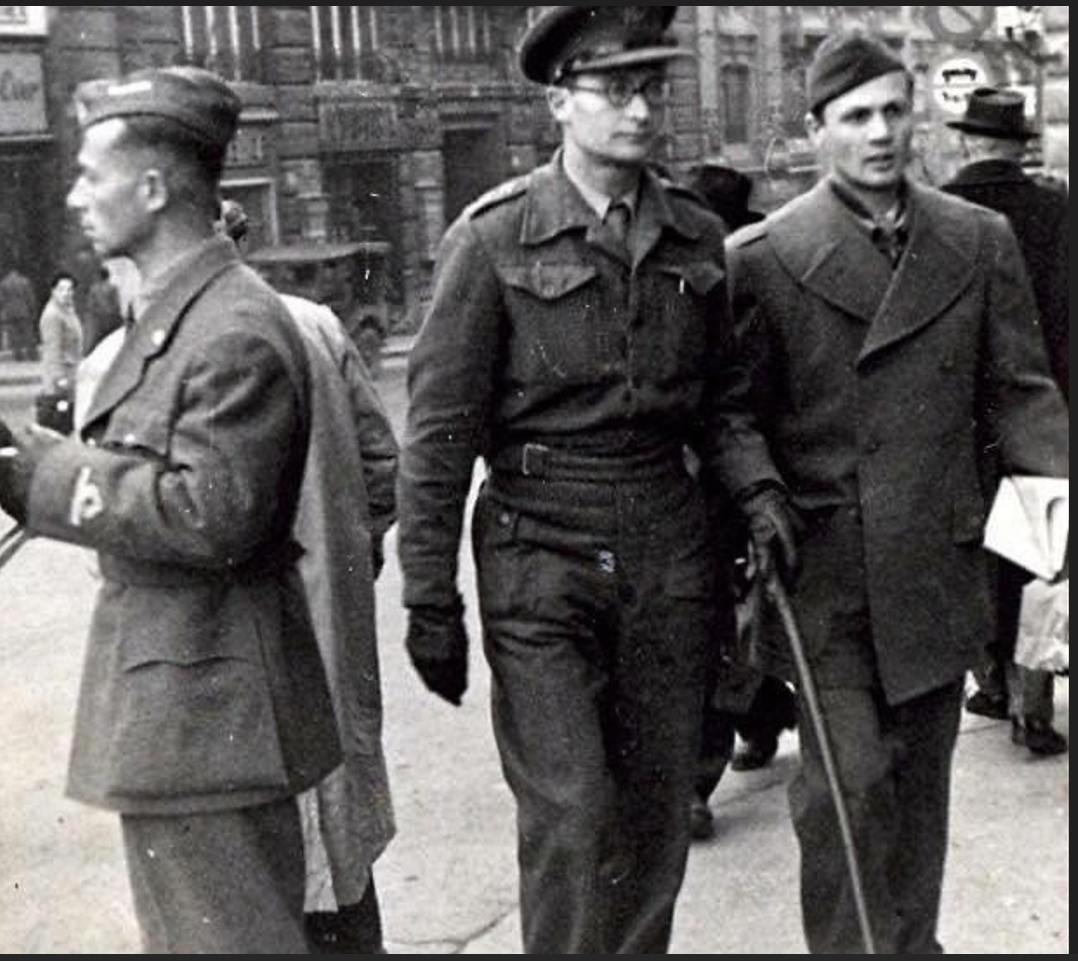News:
Salvatore Scarpitta, “Monument Man”: His Daughter Recalls his Exploits in WWII
By Charles Vincent Sabba Jr
He was devastated by the destruction the Germans brought on its Italian cultural patrimony

The artists of Leo Castelli Gallery. Sal is in last row, third from right. The young Andy Warhol, visiting, is in the lower left corner
During WWII, a specialized unit was formed that was made up of both American and British personnel that was called the Monuments, Fine Arts, and Archives unit (MFAA). This unit is better known today as the Monuments Men, as made famous by the 2014 film directed and produced by George Clooney. The MFAA was made up largely of civilian men and women, with a few enlisted men, who were artists, art historians, archeologists, architects and archivists. Their mission was to safeguard cultural heritage in the war theater. They recovered millions of artworks that were looted by the Nazis and assisted the Italians in reconstructing many architectural wonders that were damaged by the bombing such as churches and bridges (they helped to start repairs on over 700 buildings of historical importance).
One of the enlisted men that was assigned to the MFAA was Salvatore Scarpitta, a renowned artist who after the war, exhibited at the eminent Tartaruga Gallery in Rome, had ten one-man exhibits at the Leo Castelli Gallery in New York, exhibited in numerous Venice Biennales and has work in the permanent collection of the Modern Museum of Art in New York, to name only a few of his artistic achievements of his lifetime. Scarpitta was a U.S. Navy sailor assigned to the MFAA and he and all the other art experts in the unit were awarded the Congressional Gold Medal for their service.

Salvatore Scarpitta in uniform (on right facing camera).
Scarpitta was born into a family of creatives. His father was a sculptor who was born in Palermo and did major commissions in the Los Angeles area and his mother was an actress. Salvatore traveled to Sicily at age seventeen to study at the Architectural School of Palermo. He then attended the Royal Academy of Art in Rome and completed his studies there in 1940. At this time, his parents were staying in Sicily while his father was completing commissions there. In June 1940, Italy declared war on Britain and France, and they were unable to leave Italy. The Scarpitta family made its way up to Scanno, Abruzzo where they all actively participated in the resistance, which was responsible for sneaking hundreds of allied military personnel across enemy lines to safety.
At one point, Salvatore was arrested in Rome and was placed under surveillance by the fascist government. He fled to the mountains where he joined up with a group of Italian partisans and eventually, he made his way to south Italy, where he joined the U.S. Navy. He met the director of the MFAA Subcommission, Lt. Col. Ernest DeWald, who inducted him into the Monuments Men Unit.
I spoke to Scarpitta’s daughter, Lola Scarpitta (the third generation of artists in this line of creative greats) and she recounted some of Salvatore’s duties in the Monuments Men Unit: “My father’s first duties were to document architectural structures such as churches and bridges and prevent damage from the bombing. They worked from Rome to Monte Cassino and travelled south. Later, he and his colleagues were sent to Tuscany where he was tasked at documenting thousands of artworks that the Nazis hid in depositories, salt mines and everywhere they had their little caches. They used him for everything, and it was very tiring work. Some of the depositories were very humid, and the conditions were terrible for storing artworks, but the Nazis didn’t care. They assumed they would have a certain amount of loss.”
Lola Scarpitta
“My father was devastated by seeing so many beautiful ancient churches brought to rubble. The Abbey of Montecassino devastated him the most. This is somebody who went through a war and saw many people die. Later in life, as an artist, he was very antiwar. He saw the destruction of civilization in people, buildings, and art.”
“My family was hardwired for art DNA wise. After the war, my father remained in Italy as an artist until 1958. He was very well received by Italians in the artworld. He was friends with many great Italian artists like Mario Maffai and Renato Guttuso. He shared a studio with Cy Twombly in Rome. The great gallerist Leo Castelli, along with Frederick Keisler and Willem De Kooning, convinced my father to join Castelli’s New York artist stable and he moved to New York and Twombly took over the studio in Rome. De Kooning was one of my father’s best friends. Guys like Twombly, De Kooning, my father and many others were the innovators of modern art.”
It is a well-used nomination that the WWII generation was the “Greatest Generation,” a nomination I would vehemently argue is true. As with all great epochs in which large numbers of extraordinary people lived, there were always a handful that were so special they stood out. Salvatore Scarpitta was one of the greatest of the greatest generation!


